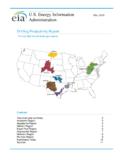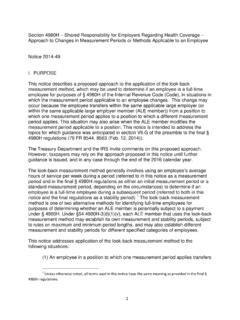Transcription of Government Security Classifications FAQ Sheet 2: …
1 Government Security Classifications FAQ Sheet 2: managing information Risk at OFFICIAL. march 2014 . This FAQ describes how risk management activities should be conducted for the new OFFICIAL classification . It outlines the typical circumstances where OFFICIAL information can be securely managed on specific types of ICT infrastructure. These circumstances are directly informed by the Threat Model for OFFICIAL (Annex A) and ICT use cases are provided as examples to help inform departmental risk decisions (Annex B). There are more detailed technical standards and guidance available for the relevant ICT. Strategy Programmes (End User Devices, Public Services Network and G-Cloud) and the wider body of protective Security policy advice is set out in the HMG Security Policy Framework alongside any statements of residual risk associated with the use of a particular product or service.
2 Key Principles The OFFICIAL classification will contain a wide range of information of varying sensitivities, and with differing consequences resulting from compromise or loss. It is for risk owners to properly understand the value and sensitivity of their information , and the ways in which they work with it, in order to make informed, risk management decisions. At OFFICIAL, Government -wide Security standards will generally be achieved by delivering common Security outcomes rather than via generic controls. risks must always be effectively managed but there will opportunities for organisations to develop innovative solutions and take advantage of good commercial practices and tools.
3 Security measures must always be proportionate and driven by the business requirement. The Threat Model for OFFICIAL will provide the broad parameters in which Security should be designed and implemented. How do we accredit OFFICIAL systems? Accreditation is the process whereby an organisation makes an informed business decision on whether they wish to accept the risks associated with a given capability, balanced against the business opportunities that it brings. The responsibility to manage this process is usually delegated from the senior risk owning executive, to an accreditor. The Government Security Classifications Policy does not change this principle.
4 Version Page 1 of 17. Will we need to re-accredit existing or legacy systems? No. Risk assessments will remain applicable under the new Classifications policy as long as your system architecture and business processes have not changed as a result. Organisations may wish to re-evaluate existing accreditations against the approaches which have been developed to complement the new policy ( CPA Foundation Grade, End User Device Platform Guidance, Cloud Security Principles), as there may be opportunities to streamline processes or realise efficiencies. Will IA Standard (IS) 1/2 change? No. IS1/2 provides a common approach for information risk assessment, management and assurance activities.
5 Used properly, IS1/2 remains an appropriate method for assessing and managing risk and therefore will not change for the launch of the Government Security Classifications Policy. How do I use IS1/2 for assessing risk to OFFICIAL systems? IS1/2 remains unchanged under the new Classifications policy. The fundamental aim of an IS1/2 risk assessment is to assess impact, threat and vulnerability in order to produce qualitative, business driven, risk statements. These principles apply equally, regardless of the classification regime in use. The output from the risk assessment process then forms a basis for the effective management of risk.
6 When practitioners assess risk they can continue to use the existing IS1/2 risk assessment method. However, they should ensure that the analysis fully takes account of business requirements; the Threat Model for OFFICIAL and doesn t simply step through the IS1/2. method without considered application. The output from an IS1/2 risk assessment should always be a business focused risk narrative and not a list of generic or meaningless statements. What is happening to Business Impact Levels (BILs)? IS1/2 provides Security professionals with a method for conducting a risk assessment, which includes an assessment of impact should a risk be realised.
7 BILs were originally conceived as a means of normalising and articulating the output of such an impact assessment in the course of an overall risk assessment. However, BILs have been widely misused beyond their intended purpose, which has led to significant negative outcomes. There is no longer any mandatory or policy requirement for the use of BILs and they do not map to the new Classifications . Reference by a Security professional to the BIL tables in IS1/2 remains acceptable in the course of a comprehensive risk assessment provided that: Version Page 2 of 17. a) They are used appropriately and as intended.
8 In particular, BILs should not be used to describe the Security offered by an IT system, service or device, or as a level of accreditation. BILs should never be used as a proxy for specifying contractual Security requirements. b) The assessment uses the BIL tables for reference only as part of the overall IS1/2. risk assessment process. It is essential that the Security professional conducts analysis and enumerates the actual business impact. This should be the output of the impact analysis and not simply a number based on a broadly applicable statement from the BIL tables. c) Effective impact and risk assessment is a business process and therefore the outputs from these activities should be specified in business language.
9 How will I know how secure an ICT system is without BILs? BILs have never provided a level of Security in themselves; rather they can indicate the impact of loss or compromise of information , stored or processed by a particular system. In the past people have misused BIL value as a proxy for Security requirements, often leading to assumptions of the Security measures which are present in that system. Interpretation of Security requirements, defined solely by a BIL value, can vary considerably so assumptions such as these can cause confusion, add cost or potentially even increase risk. Rather than attempt to create a shorthand or label to describe the implementation of Security , practitioners should aim to be as clear and explicit as possible about the controls they apply and the risks that they are mitigating in any given system.
10 It should always be possible to articulate this in plain English and without recourse to jargon. At OFFICIAL, risk owners should expect compliance with any relevant legislation, the classification Policy Controls Framework and alignment with good commercial practice and common standards typically provided by pan- Government frameworks such as the PSN. and G-Cloud. Will the new classification policy affect my organisation's appetite for information risk? We do not anticipate organisations accepting more information risk as a result of the classification Policy, however there are a number of areas where the focus differs from current arrangements.












